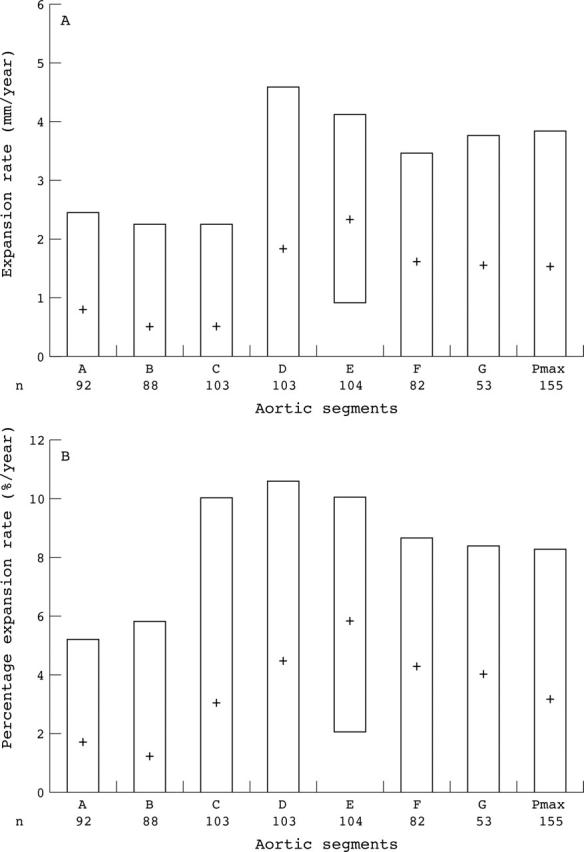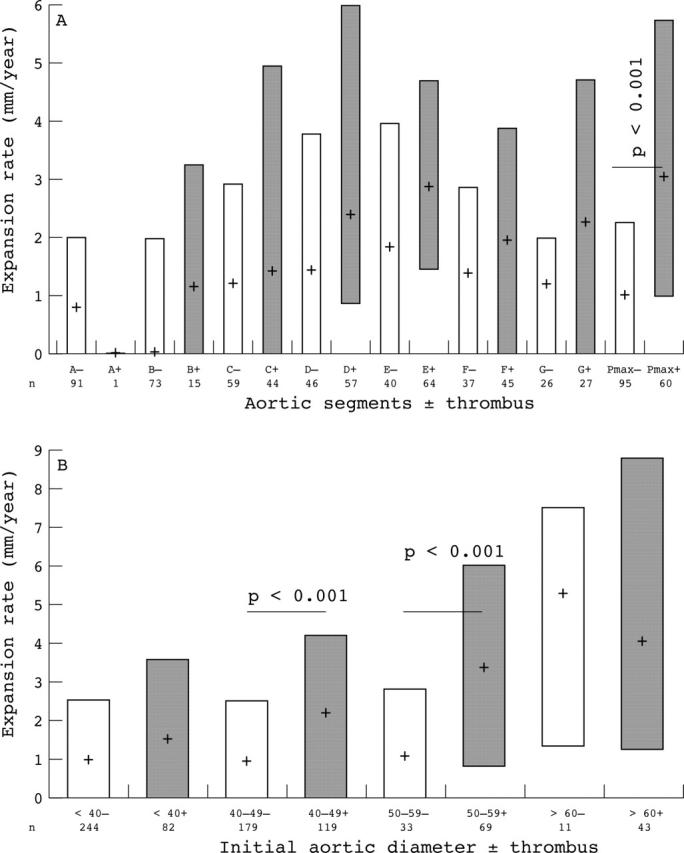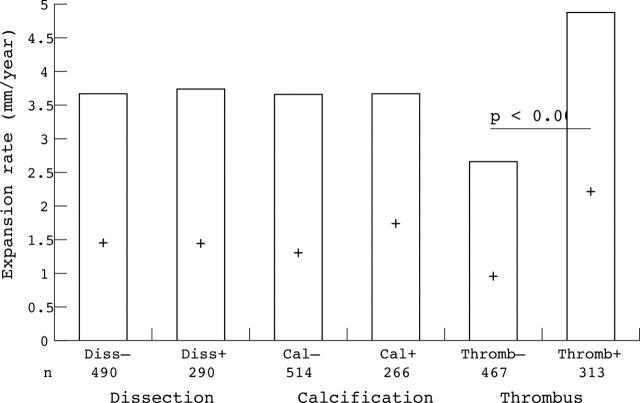Abstract
OBJECTIVE—To examine the expansion of aneurysmal aortic segments (⩾ 35 mm) and to assess the impact of clinical and patho-anatomical factors on aneurysm expansion. DESIGN—87 consecutive patients (mean age 63.6 years, range 22-84 years) were studied using serial (six month intervals) computed tomographic or magnetic resonance imaging to monitor progression of thoracic aortic aneurysms. Aortic diameter was measured at seven predetermined segments and at the site of maximum aortic dilatation (MAX). RESULTS—780 segment intervals were identified. The median overall aneurysm expansion rate was 1.43 mm/year. This increased exponentially with incremental aortic diameter (p < 0.01) and varied by anatomical segment (p < 0.05). The presence of intraluminal thrombus (p < 0.01) but not dissection or calcification was associated with accelerated growth. Univariate analysis identified thrombus (p < 0.001), previous stroke (p < 0.002), smoking (p < 0.01), and peripheral vascular disease (p < 0.05) as factors associated with accelerated growth in MAX. Dissection, wall calcification, and history of hypertension did not affect expansion. β Blocker treatment was not associated with protection. Multivariate analysis confirmed the positive effect of intraluminal thrombus and previous cerebral ischaemia, and the negative effect of previous aortic surgery on aneurysm growth. These findings translated into a mathematical equation describing exponential aneurysm expansion. CONCLUSIONS—Aneurysmal thoracic aortic segments expand exponentially according to their initial size and their anatomical position within the aorta. The presence of intraluminal thrombus, atherosclerosis, and smoking history is associated with accelerated growth and may identify a high risk patient group for close surveillance. Keywords: thoracic aortic aneurysm; expansion rate
Full Text
The Full Text of this article is available as a PDF (144.3 KB).
Figure 1 .
Box plot (median and interquartile range), showing distribution of initial aortic diameter throughout the segments studied (see table 1 for segment code). p < 0.05 (Kruskal-Wallis); n = number of segments.
Figure 2 .

Linear (A) and percentage (B) expansion rate according to segment level (see table 1 for segment code). p < 0.01 (Kruskal-Wallis); n = number of segments.
Figure 3 .
Expansion rate according to initial aortic diameter: p < 0.001 (Kruskal-Wallis). Segments with initial diameter ⩾ 60 mm manifested a median expansion rate of 4 mm/year, while smaller aneurysms (< 50 mm diameter) had a median expansion rate of 1.33 mm/year (p < 0.01); n = number of segments.
Figure 4 .
Comparison of expansion rate according to presence (+) or absence (−) of dissection, calcification, and intraluminal thrombus for all segment intervals studied. Thrombus was associated with significantly greater expansion rate (p < 0.01) (Mann-Whitney); n = number of segments.
Figure 5 .

(A) Effect of thrombus on expansion rate by segment (see table 1 for segment code). There is a consistent expansion effect across all segments. (B) Effect of thrombus on expansion according to initial diameter. n = number of segments.
Selected References
These references are in PubMed. This may not be the complete list of references from this article.
- Aronberg D. J., Glazer H. S., Madsen K., Sagel S. S. Normal thoracic aortic diameters by computed tomography. J Comput Assist Tomogr. 1984 Apr;8(2):247–250. [PubMed] [Google Scholar]
- Bengtsson H., Bergqvist D., Ekberg O., Janzon L. A population based screening of abdominal aortic aneurysms (AAA). Eur J Vasc Surg. 1991 Feb;5(1):53–57. doi: 10.1016/s0950-821x(05)80927-2. [DOI] [PubMed] [Google Scholar]
- Bernstein E. F., Dilley R. B., Goldberger L. E., Gosink B. B., Leopold G. R. Growth rates of small abdominal aortic aneurysms. Surgery. 1976 Dec;80(6):765–773. [PubMed] [Google Scholar]
- Bickerstaff L. K., Pairolero P. C., Hollier L. H., Melton L. J., Van Peenen H. J., Cherry K. J., Joyce J. W., Lie J. T. Thoracic aortic aneurysms: a population-based study. Surgery. 1982 Dec;92(6):1103–1108. [PubMed] [Google Scholar]
- Bland J. M., Altman D. G. Statistical methods for assessing agreement between two methods of clinical measurement. Lancet. 1986 Feb 8;1(8476):307–310. [PubMed] [Google Scholar]
- Cambria R. A., Gloviczki P., Stanson A. W., Cherry K. J., Jr, Bower T. C., Hallett J. W., Jr, Pairolero P. C. Outcome and expansion rate of 57 thoracoabdominal aortic aneurysms managed nonoperatively. Am J Surg. 1995 Aug;170(2):213–217. doi: 10.1016/s0002-9610(99)80289-x. [DOI] [PubMed] [Google Scholar]
- Coady M. A., Rizzo J. A., Hammond G. L., Mandapati D., Darr U., Kopf G. S., Elefteriades J. A. What is the appropriate size criterion for resection of thoracic aortic aneurysms? J Thorac Cardiovasc Surg. 1997 Mar;113(3):476–491. doi: 10.1016/S0022-5223(97)70360-X. [DOI] [PubMed] [Google Scholar]
- Cohen J. R., Mandell C., Margolis I., Chang J., Wise L. Altered aortic protease and antiprotease activity in patients with ruptured abdominal aortic aneurysms. Surg Gynecol Obstet. 1987 Apr;164(4):355–358. [PubMed] [Google Scholar]
- Coselli J. S., de Figueiredo L. F. Natural history of descending and thoracoabdominal aortic aneurysms. J Card Surg. 1997 Mar-Apr;12(2 Suppl):285–291. [PubMed] [Google Scholar]
- Crawford E. S., Cohen E. S. Aortic aneurysm: a multifocal disease. Presidential address. Arch Surg. 1982 Nov;117(11):1393–1400. doi: 10.1001/archsurg.1982.01380350001001. [DOI] [PubMed] [Google Scholar]
- Crawford E. S., DeNatale R. W. Thoracoabdominal aortic aneurysm: observations regarding the natural course of the disease. J Vasc Surg. 1986 Apr;3(4):578–582. doi: 10.1067/mva.1986.avs0030578. [DOI] [PubMed] [Google Scholar]
- Cronenwett J. L., Murphy T. F., Zelenock G. B., Whitehouse W. M., Jr, Lindenauer S. M., Graham L. M., Quint L. E., Silver T. M., Stanley J. C. Actuarial analysis of variables associated with rupture of small abdominal aortic aneurysms. Surgery. 1985 Sep;98(3):472–483. [PubMed] [Google Scholar]
- Dapunt O. E., Galla J. D., Sadeghi A. M., Lansman S. L., Mezrow C. K., de Asla R. A., Quintana C., Wallenstein S., Ergin A. M., Griepp R. B. The natural history of thoracic aortic aneurysms. J Thorac Cardiovasc Surg. 1994 May;107(5):1323–1333. [PubMed] [Google Scholar]
- Delin A., Ohlsén H., Swedenborg J. Growth rate of abdominal aortic aneurysms as measured by computed tomography. Br J Surg. 1985 Jul;72(7):530–532. doi: 10.1002/bjs.1800720709. [DOI] [PubMed] [Google Scholar]
- Galla J. D., Ergin M. A., Lansman S. L., DeAsla R. A., Nguyen K. H., McCullough J. N., Griepp R. B. Identification of risk factors in patients undergoing thoracoabdominal aneurysm repair. J Card Surg. 1997 Mar-Apr;12(2 Suppl):292–299. [PubMed] [Google Scholar]
- Hirose Y., Hamada S., Takamiya M., Imakita S., Naito H., Nishimura T. Aortic aneurysms: growth rates measured with CT. Radiology. 1992 Oct;185(1):249–252. doi: 10.1148/radiology.185.1.1523317. [DOI] [PubMed] [Google Scholar]
- Hirose Y., Hamada S., Takamiya M. Predicting the growth of aortic aneurysms: a comparison of linear vs exponential models. Angiology. 1995 May;46(5):413–419. doi: 10.1177/000331979504600508. [DOI] [PubMed] [Google Scholar]
- Johansson G., Markström U., Swedenborg J. Ruptured thoracic aortic aneurysms: a study of incidence and mortality rates. J Vasc Surg. 1995 Jun;21(6):985–988. doi: 10.1016/s0741-5214(95)70227-x. [DOI] [PubMed] [Google Scholar]
- Juvonen T., Ergin M. A., Galla J. D., Lansman S. L., McCullough J. N., Nguyen K., Bodian C. A., Ehrlich M. P., Spielvogel D., Klein J. J. Risk factors for rupture of chronic type B dissections. J Thorac Cardiovasc Surg. 1999 Apr;117(4):776–786. doi: 10.1016/S0022-5223(99)70299-0. [DOI] [PubMed] [Google Scholar]
- Juvonen T., Ergin M. A., Galla J. D., Lansman S. L., Nguyen K. H., McCullough J. N., Levy D., de Asla R. A., Bodian C. A., Griepp R. B. Prospective study of the natural history of thoracic aortic aneurysms. Ann Thorac Surg. 1997 Jun;63(6):1533–1545. doi: 10.1016/s0003-4975(97)00414-1. [DOI] [PubMed] [Google Scholar]
- Kouchoukos N. T., Dougenis D. Surgery of the thoracic aorta. N Engl J Med. 1997 Jun 26;336(26):1876–1888. doi: 10.1056/NEJM199706263362606. [DOI] [PubMed] [Google Scholar]
- Krupski W. C., Bass A., Thurston D. W., Dilley R. B., Bernstein E. F. Utility of computed tomography for surveillance of small abdominal aortic aneurysms. Preliminary report. Arch Surg. 1990 Oct;125(10):1345–1350. doi: 10.1001/archsurg.1990.01410220129018. [DOI] [PubMed] [Google Scholar]
- MacSweeney S. T., Ellis M., Worrell P. C., Greenhalgh R. M., Powell J. T. Smoking and growth rate of small abdominal aortic aneurysms. Lancet. 1994 Sep 3;344(8923):651–652. doi: 10.1016/s0140-6736(94)92087-7. [DOI] [PubMed] [Google Scholar]
- MacSweeney S. T., O'Meara M., Alexander C., O'Malley M. K., Powell J. T., Greenhalgh R. M. High prevalence of unsuspected abdominal aortic aneurysm in patients with confirmed symptomatic peripheral or cerebral arterial disease. Br J Surg. 1993 May;80(5):582–584. doi: 10.1002/bjs.1800800510. [DOI] [PubMed] [Google Scholar]
- Masuda Y., Takanashi K., Takasu J., Morooka N., Inagaki Y. Expansion rate of thoracic aortic aneurysms and influencing factors. Chest. 1992 Aug;102(2):461–466. doi: 10.1378/chest.102.2.461. [DOI] [PubMed] [Google Scholar]
- Panneton J. M., Hollier L. H. Nondissecting thoracoabdominal aortic aneurysms: Part I. Ann Vasc Surg. 1995 Sep;9(5):503–514. doi: 10.1007/BF02143869. [DOI] [PubMed] [Google Scholar]
- Perko M. J., Nørgaard M., Herzog T. M., Olsen P. S., Schroeder T. V., Pettersson G. Unoperated aortic aneurysm: a survey of 170 patients. Ann Thorac Surg. 1995 May;59(5):1204–1209. doi: 10.1016/0003-4975(95)00132-5. [DOI] [PubMed] [Google Scholar]
- Pillari G., Chang J. B., Zito J., Cohen J. R., Gersten K., Rizzo A., Bach A. M. Computed tomography of abdominal aortic aneurysm. An in vivo pathological report with a note on dynamic predictors. Arch Surg. 1988 Jun;123(6):727–732. doi: 10.1001/archsurg.1988.01400300073012. [DOI] [PubMed] [Google Scholar]
- Pitt M. P., Bonser R. S. The natural history of thoracic aortic aneurysm disease: an overview. J Card Surg. 1997 Mar-Apr;12(2 Suppl):270–278. [PubMed] [Google Scholar]
- Pressler V., McNamara J. J. Aneurysm of the thoracic aorta. Review of 260 cases. J Thorac Cardiovasc Surg. 1985 Jan;89(1):50–54. [PubMed] [Google Scholar]
- Pressler V., McNamara J. J. Thoracic aortic aneurysm: natural history and treatment. J Thorac Cardiovasc Surg. 1980 Apr;79(4):489–498. [PubMed] [Google Scholar]
- Rizzo J. A., Coady M. A., Elefteriades J. A. Procedures for estimating growth rates in thoracic aortic aneurysms. J Clin Epidemiol. 1998 Sep;51(9):747–754. doi: 10.1016/s0895-4356(98)00050-x. [DOI] [PubMed] [Google Scholar]
- Robicsek F., Thubrikar M. J. Hemodynamic considerations regarding the mechanism and prevention of aortic dissection. Ann Thorac Surg. 1994 Oct;58(4):1247–1253. doi: 10.1016/0003-4975(94)90523-1. [DOI] [PubMed] [Google Scholar]
- Shimada I., Rooney S. J., Farneti P. A., Riley P., Guest P., Davies P., Bonser R. S. Reproducibility of thoracic aortic diameter measurement using computed tomographic scans. Eur J Cardiothorac Surg. 1999 Jul;16(1):59–62. doi: 10.1016/s1010-7940(99)00125-6. [DOI] [PubMed] [Google Scholar]
- Shimada I., Rooney S. J., Pagano D., Farneti P. A., Davies P., Guest P. J., Bonser R. S. Prediction of thoracic aortic aneurysm expansion: validation of formulae describing growth. Ann Thorac Surg. 1999 Jun;67(6):1968–1980. doi: 10.1016/s0003-4975(99)00435-x. [DOI] [PubMed] [Google Scholar]
- Strachan D. P. Predictors of death from aortic aneurysm among middle-aged men: the Whitehall study. Br J Surg. 1991 Apr;78(4):401–404. doi: 10.1002/bjs.1800780407. [DOI] [PubMed] [Google Scholar]
- Svensson L. G., Crawford E. S., Hess K. R., Coselli J. S., Raskin S., Shenaq S. A., Safi H. J. Deep hypothermia with circulatory arrest. Determinants of stroke and early mortality in 656 patients. J Thorac Cardiovasc Surg. 1993 Jul;106(1):19–31. [PubMed] [Google Scholar]
- Szilagyi D. E., Smith R. F., DeRusso F. J., Elliott J. P., Sherrin F. W. Contribution of abdominal aortic aneurysmectomy to prolongation of life. Ann Surg. 1966 Oct;164(4):678–699. doi: 10.1097/00000658-196610000-00014. [DOI] [PMC free article] [PubMed] [Google Scholar]
- Wolf Y. G., Thomas W. S., Brennan F. J., Goff W. G., Sise M. J., Bernstein E. F. Computed tomography scanning findings associated with rapid expansion of abdominal aortic aneurysms. J Vasc Surg. 1994 Oct;20(4):529–538. doi: 10.1016/0741-5214(94)90277-1. [DOI] [PubMed] [Google Scholar]
- Wolinsky H., Glagov S. Comparison of abdominal and thoracic aortic medial structure in mammals. Deviation of man from the usual pattern. Circ Res. 1969 Dec;25(6):677–686. doi: 10.1161/01.res.25.6.677. [DOI] [PubMed] [Google Scholar]





